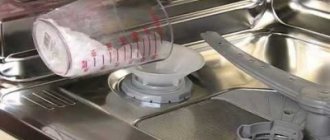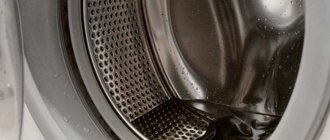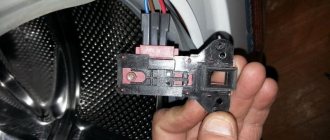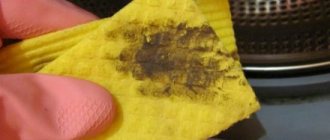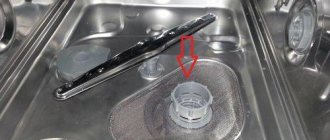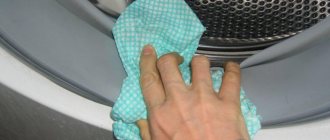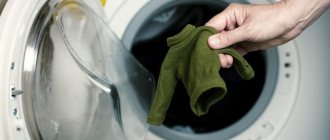If the washing device has finished working, but you find residual water in the washing powder or softener tray, it is recommended to urgently diagnose the machine to identify the exact cause of the problem. A similar problem can occur in a device of any brand - Bosch, Indesit, Ariston, Candy, Samsung, LG. Stagnation of water in the compartment indicates that certain interruptions have occurred in the system. We invite you to figure out together why water remains in the air conditioner compartment in your washing machine.
Errors during operation
Powder may remain in the tray for various reasons.
For example, if there is high humidity in the room where the washing machine is installed. Most residents of our country try to increase the free space in their living space by installing a washing machine in the bathroom. If there is poor ventilation, the tray will not dry out. This means that the powder that the housewife pours into the tray will stick to it and will not be washed out during operation of the unit. Another reason is careless use of the washing machine. For example, powder may end up in the conditioner compartment. The pressure may not be enough to wash it out. To avoid this problem, add the powder using a measuring cup. This will help prevent powder from getting into another compartment.
But this is the simplest reason for the problem described. And it is unlikely that our readers turned to our company’s website for such an answer. Most likely you have already looked at it. This means you are thinking about more serious problems. And they really can be if there is powder left in the tray. But don’t worry ahead of time.
Wrong choice of powder
The remaining parts of the powder are also affected by its composition. You should not save several tens of rubles and purchase low-quality detergent. Low quality powders and name brand counterfeits may contain insoluble compounds that will remain in the tray. Yes, and washing such powders will be quite bad.
If the washing powder remains in the tray, then there is a high probability that you are using the wrong detergent that is suitable for your equipment. It is best to listen to its manufacturer and buy detergents recommended by them.
Incorrect water supply
But the most dangerous problem indicated by the remaining powder in the tray is that it is not washed away due to improper water supply. Such a breakdown can occur due to:
- Kink in the water supply hose;
- Input filter clogged;
- Low water pressure in the water supply;
- Supply of dirty and poor quality water.
Pay attention to the water supply hose. If it is bent or has insufficient diameter, then this can affect not only the remaining powder in the tray, but also the long-term collection of water by the washing machine itself. . If the washing machine does not pick up powder, then pay attention to the filter
The mesh protects the injectors from plaque and large contaminants. She takes the blow herself. And if the filter gets clogged, it will affect the water pressure.
If the washing machine does not pick up powder, then pay attention to the filter. The mesh protects the injectors from plaque and large contaminants
She takes the blow herself. And if the filter gets clogged, it will affect the water pressure.
This problem is also affected by clogged water supply pipes. And then the technician will have to repair your washing machine. Cleaning pipes is not the most difficult task. But it requires certain knowledge. If a person does not have them, he can only harm his washing machine.
The cause of clogging of the pipes may be foreign objects that have entered the compartment through negligence or pieces of undissolved powder.
Problem #3: The fabric softener compartment is filled with water.
If the fabric softener compartment fills with water after finishing the wash cycle, the problem may be similar to the one described above. Although the reason may be completely different. The situation could be as follows:
- Is the fabric softener container clogged?
It may seem unlikely that fabric softener will leak out of the container but water will not, but it is worth cleaning the container as described above as this is the easiest way to fix the problem. - Is your washing machine level?
If your washing machine is not level, it can cause drainage problems, causing the fabric softener container to fill with water. Use a level (or download a water level app) to find out if the front, back, left, and right sides of your car are level. If you see that one side is uneven, correct this situation. Improper installation of your washing machine can cause many other problems and lead to problems that require costly repairs. Don't wait until you need to make repairs, it's actually quite easy to adjust the legs by twisting them up or down. Read your washing machine manual to find out how to do this.
Article on the topic: Ballu air conditioners whose production
Prevention measures
To avoid the problem of leakage from the powder tray, it is advisable to remember the following preventive measures:
- The washing machine must be installed according to the rules, using a building level tool.
- The powder tray must be washed periodically to avoid clogging.
- The powder receptacle should be protected from children's pranks.
- For washing, only special products intended for automatic washing machines should be used. You cannot pour, for example, soap shavings into the cuvette. This can not only lead to clogging and leakage of water from the tray, but will also lead to other, more serious damage.
Breakage prevention
It is easier to prevent a malfunction than to repair it later. It is recommended to follow the installation rules described in the instructions. Some users artificially lengthen the drain hose, thereby increasing the load on the pump.
Before washing, things need not only to be sorted, but also to remove foreign objects from pockets. Clothes with sequins and beads are washed inside out only, or placed in a special bag.
The drain filter is periodically checked for blockages.
Follow these simple recommendations and your washing machine will last much longer.
Rules for using detergents
Most often, modern units use powdered products with different compositions. They can be fully or partially synthetic, concentrated, made from soap or herbal extracts, but their packaging must be labeled “for automatic washing.”
Where should I put my laundry detergent?
It is strictly not recommended to use preparations for manual treatment of laundry: they cause strong foaming, which can lead to clogging of the hose and, as a result, to leaks.
Powder is poured into different types of washing devices in different ways. Semi-automatic machines usually do not have a separate cuvette for detergents; the powder is poured into the tank along with the laundry.
In machines with vertical loading, the cells for washing powder, conditioner and other products have larger parameters than in front-loading machines.
In machines with vertical loading, the cells for powder, conditioner, and bleach are located on the inside of the hatch located at the top.
Image gallery
Photo from
Washing machine Indesit EWD71052CIS
Washing machine Hotpoint AristonAQS1D
Washing machine Bosch WAW32540OE
Washing machine Whirlpool AWE6516/1
For front washing machines, the detergent compartment is usually located in the upper left corner. Depending on the brand, its design may vary.
Let's take a closer look at the design of the powder tray. The retractable cuvette, designed to bring detergent into the drum, has a well-thought-out device. As a rule, it is made of plastic: the front panel is the color of the body, and the inner surface is white or gray.
This figure shows a schematic representation of a standard compartment for receiving detergents, consisting of three cells of different sizes
The device is divided into three, less often into four compartments, which are marked with letters, symbols, Roman or Arabic numerals:
- The largest module, designated by numbers II, 2 or letter B, is filled with the product necessary for the main washing cycle.
- The compartment is medium in size, marked with the numbers I, 1 or the letter A, and is designed for filling with washing powder, which is used for pre-washing clothes. You can also add bleach or stain remover here.
- The smallest compartment, which is usually located on the left, is intended for filling flavors and conditioners. This part can be marked with the numbers III, 3, the word Softener, and the image of a flower (star).
To regulate the amount of softening agent, a limit strip with the word "max" is often applied to the conditioner compartment, indicating the limit limit.
In some models, for example, in Samsung machines, a special dispenser included in the kit is used to apply liquid products. It is inserted into the corresponding compartment of the cuvette
In some cases, this compartment is divided into two parts by a partition, and a removable module can also be used. One of them is intended for the conditioner itself, the second for diluted starch, flavoring or other additional substance.
Rules for loading detergent
The powder is poured into the cuvette randomly; it is not at all necessary to distribute it evenly throughout the entire container: the main thing is that it does not spill out over the edges. After the manipulation, you need to close the compartment tightly, and only then start the machine.
When selecting a prewash/main wash and rinse with fragrance and softener, all products can be added to the cuvette at the same time
Some washing machines have levels in the cells that allow you to control the amount of detergent added. However, housewives often pour the powder by eye, remembering the amount from previous washes.
The design features of the machine ensure that detergents (powder, conditioner) enter the drum along with the flow of water supplied through the tray. Each compartment has holes that create conditions for dissolving these products with a stream of water and transferring them to the tank.
Complete transportation of substances is facilitated by both the high pressure under which water is supplied and the smooth walls of the powder receiving device, which facilitate the release of the dissolved product.
Causes of leakage and solutions
When looking for the cause of a leak, LG will help determine the location of the leak and at what stage of the wash cycle the water began to pour out.
Water leaking from the left corner at the bottom of the housing
There is a drain filter at the bottom of the LG washing machine. An emergency drain hose is located next to it. There can be several reasons for a leak:
- poorly secured plug on the emergency drain hose;
- loose drain filter;
- the drain filter is clogged;
- pump clogged/broken;
- broken/clogged pipes.
After removing the panel at the bottom of the front side of the LG washing machine, access to the filter opens. Before unscrewing it, you need to place rags to absorb any water that may still be in the washing machine. The filter is unscrewed, cleaned and washed in water. After processing, it is installed in place. If it is damaged, the part should be replaced with a new one. When installing the filter in its intended place, you should ensure that the installation is carried out efficiently. If installed carelessly, a leak may occur from this location again.
You can watch the video on how to clean the drain filter in an LG car:
When dialing
If water begins to pour out even at the stage of entering the LG washing machine, you should check the condition of the pipes and the inlet hose. In order to carry out an inspection, you will have to partially disassemble the washing machine.
The inspection should be carried out methodically, starting with the analysis of the filling hose, gradually moving to the nozzles. If damage to the pipes or hose is detected, they should be replaced with new ones, since repair is not advisable.
All pipes must be connected very securely, checking the quality of the pipes.
From below
Water spreading under an LG machine can be either a relatively simple breakdown or a serious one that will cost several thousand rubles.
The cause of the leak may be:
- Worn or damaged pipes leading to the dispenser, tank, etc.
- Damaged tank...
- Destroyed bearings.
- Clogged or damaged pump.
- Violation of the integrity of the hoses that supply and discharge water.
- Wear of gaskets.
- Broken seal of the heating element seat.
All these areas and working units can only be analyzed when disassembling the washing machine. For some types of breakdowns (for example, when replacing a tank), repairs are only possible in a workshop, since free space will be required to completely disassemble the machine, and special tools.
Replacement of hoses and pipes is usually carried out on site. The same applies to replacing gaskets that no longer perform their intended functions.
In addition to the reasons listed, water leakage can be a consequence of previous repairs (successful or unsuccessful), when an old solder joint or previously treated joints begin to leak water some time after the previous repair. In such situations, repeated repairs cannot be avoided.
Why water flows from below the washing machine, read in this article.
From the tray
A leak from the tray can be caused by:
- impaired passage of water from the dispenser into the pipe;
- damage to the plastic of the powder receptacle;
- high pressure in the water supply.
First, you should inspect the tray itself and make sure that there is no damage to the body and that nothing interferes with the passage of water.
If there are also no problems with water pressure, then you will need to check the outlet pipe for defects and the quality of the joints. To carry out inspection, it will be necessary to remove the back and top panels.
From the hatch
Leakage from the LG hatch door can occur on the outside and inside of the washing machine.
Circumstances that lead to the appearance of water on the floor may include the following:
- Violation of the integrity of the rubber seal.
- A foreign object has gotten between the rubber band and the door.
If the reason is sloppy stacking of laundry, then no repairs are required. In the future, you just need to be careful when placing things in the washing machine.
A cuff defect is determined quite simply. The rubber band should be examined carefully. If there are holes, the cuff must be replaced. The part should not be repaired. Read how to replace the cuff here.
How are faults displayed by different manufacturers?
As soon as a breakdown occurs, the result of which is water in the washing machine, the device will notify you about it. The display of faults is recorded on the display:
Alarm about a problem on the display of the LG washing machine
Why is water leaking from under the washing machine?
The main reasons for this defect are: violations of the rules of operation of the SMA, the use of low-quality washing powders, as well as defects that arose during the manufacture of components and parts. If we talk about specific malfunctions, these include:
- violation of tightness at the connections of the inlet and drain hoses, violation of their integrity;
- leak in the drain pump (pump);
- damage to the tank body (crack or hole);
- violation of the tightness of the connections of the filler and drain pipes inside the SM housing;
- damage to the elastic cuff of the hatch door;
- wear of the oil seal that seals the bearings on the drum shaft;
- There is a blockage in the hopper of the washing powder dispenser tray.
Damage to pipes
If inspection of the hatch cuff and dispenser did not lead to the detection of a leak, it is necessary to remove the top cover of the machine and carefully inspect the pipes that lead to the dispenser hopper from the inlet valve.
Worn and damaged pipes usually let water through. To eliminate the leak, they must be replaced. The filler pipe may leak where it connects to the tank. This will be indicated by characteristic streaks on the tank. In this case, the pipe must be removed, thoroughly cleaned, dried and installed in its original place, fixing it with epoxy resin or glue. If the pipe is chafed, the part in the damaged area is sealed with a piece of thin rubber. The pipes, including the drain pipe, may leak due to loosening of the tightening clamps. Damage to the drain pipe can also be caused by solid foreign objects entering it from the tank. To eliminate the malfunction, replace the clamp or lubricate the pipe connection with sealant.
Reasons why the washing machine does not wash out the powder at all
If this happened to a new washing machine, first read the instruction manual and see if you did everything correctly? Because the most common reasons that the washing powder remains untouched and the rinse aid is in place are:
- Washing powder is poured into the wrong compartment. For example, instead of a compartment for regular washing, the powder is poured into a cuvette for preliminary washing.
- Water does not flow due to a closed valve. Check and if this is the case, then simply open the valve all the way.
- The water supply is turned off. In this case, all that remains is to wait for the water supply to resume.
Why does rinse aid remain in the dispenser tray - reasons
- Intake filter clogged. This element is located between the water supply hose and the filling valve and is a fine mesh for mechanical purification of water from impurities. The content of debris, scale, and pieces of rust in a water pipe is not uncommon, but a common occurrence in our country. Debris particles are retained on the filter and accumulate, resulting in water entering the device with less pressure. To fix the problem, you will need to clean the filter.
- Intake valve failure. The operation of this unit can be compared with a conventional water supply valve in a mixer: it opens when the device needs to draw water, closes if there is no need for water supply, with the only difference that the valve is adjusted automatically - according to the control signal of the electronic module. Due to power surges, software failures and other troubles, the valve may be blocked in a half-open state or the membrane will not open completely. As in the previous case, in the described situation the water will have low pressure, as a result of which the air conditioner is poorly washed out of the dispenser.
- Nozzle failure. If the conditioner remains in the tray, perhaps the water intended to flush it out ended up in the wrong compartment. The water distribution is adjusted by turning the nozzle, which is moved by a special cable. During long-term use, the cable may break off or get stuck, which leads to water getting into the wrong compartment. The injector may also become clogged.
Main causes of water leakage
Faulty hoses
A very common problem is water leakage at the place where the hose is connected to the machine itself. In order to eliminate it, you need to disconnect the hose and change its rubber gasket.
If the drain hose has cracks, you can try to glue it with special glue or make a patch on it. But the easiest way is to buy a new one and change it. It is not recommended to repair the inlet hose. After all, the pressure in it is always quite high, so if there is a defect, it is better to immediately replace it with a new one. You can buy any hoses for your washing machine at a regular plumbing store.
One of the reasons for the leak may be a malfunction of the hoses.
Malfunction of the washing powder compartment
If you notice that your washing machine is leaking water from the powder compartment, then most likely your unit has one of the following problems. When using the washing machine for a long time, the dispenser hopper of the machine may become clogged. This is where the powder is usually poured. Or the leak occurred due to too much water pressure in the pipes. Or there is a problem with the intake valve. If a valve malfunction is detected, water will leak under it.
It is necessary to remove the powder compartment and rinse it thoroughly. It also happens that foreign objects accidentally get there and interfere with the normal operation of the machine. Naturally, they need to be eliminated.
The washing powder dispenser hopper may become clogged.
After you have cleaned the hopper, check to see if the water leakage problem is still there. If yes, then reduce the pressure, close the water supply tap a little.
If neither one nor the other solves the problem, you will need to replace the intake valve. After all, a faulty valve increases the water pressure while the machine is rinsing the laundry.
Faulty cuff
If you often load the machine with a large amount of laundry, then most likely the hatch cuff will wear out quickly. This may cause it to become leaky. In this case, water will leak directly from the hatch.
For minor damage, waterproof glue or a rubber patch may help. After the repair, it will be necessary to remove the clamps securing the cuff and place the cuff so that the repaired area is on top.
The cuff wears out frequently
If the damage is extensive, it is best to replace the cuff completely. You can find instructions for replacing the cuff in your washing machine's user manual or online.
Filler pipe malfunction
It happens that the place where the pipe is attached to the tank of the machine becomes loose. To do this, you need to carefully examine the tank itself. If there are water leaks on it in the place where it is connected to the pipe, then the cause of the leak is clear.
To carry out repairs, the pipe must be disconnected. Next, you should remove any remaining glue, get rid of excess moisture and thoroughly dry the joint. Then use epoxy or any other waterproof glue to secure the pipe.
Malfunction of the intake valve pipe
To detect this problem, you must completely disconnect the top plastic part of the washing machine. Next, you should inspect the pipes for damage. If they are found, they must be replaced with new ones.
Damage to the machine tank
To understand whether there is damage to the tank, you need to tilt the machine so that you can carefully inspect the bottom. To do this, take a flashlight and inspect the bottom of the unit for water leaks. When loading the machine vertically, the side section must be removed for inspection.
Often the tank is damaged due to the ingress of foreign solid objects or a malfunction of the heating element. If a tank leak is detected, it should be replaced. This is quite a difficult task, so you will most likely have to call a specialist.
Oil seal malfunction
The machine's tank seal tends to wear out periodically. In this case, leakage often occurs during spinning. To detect this problem, you need to carefully inspect the tank. If traces of water are found from the bearings, then it is necessary to change the oil seal and bearings.
Damage to the drain pipe
The drain pipe is located at the bottom of the machine. It is the connection between the tank and the drain pump.
Damage to loading hatch
First of all, you should pay attention to the location of the puddle. So, if water collects closer to the front side of the machine and its amount increases during the spin cycle, the hatch seal is most likely damaged. Punctures or cuts can be caused by sharp edges of accessories on clothing or items forgotten in pockets. Over time, under the influence of water and detergents, any seal can lose its properties and allow water to pass through. If it is damaged, the sealing rubber must be replaced - it is useless to seal the cuff, since it can shrink and stretch during washing.
Sometimes leaks are also caused by a washing machine hatch that does not close tightly.
The integrity of the cuff can be damaged by exposure to aggressive substances contained in detergents or by fungal infection. You can replace the cuff yourself. Its outer part is slightly recessed into the hole in the front wall and is fixed there using a wire or plastic clamp.
It is easier to put on a clamp with an adjusting screw - after putting it in place, the clamp is gradually tightened and the screw is tightened in a certain position. After installation, the cuff should be checked for fresh leaks.
The plastic clamp can be removed by pulling towards the area where the latches meet. To remove the wire clamp, you need to pry the spring or unscrew the fixing screw. The next step is to locate the installation mark on the cuff. It is necessary to determine the fixed position of the cuff according to the tank. If there is no such mark, use a marker to mark where the cuff is located to the tank. The mounting edges must be cleaned of dirt and deposits and thoroughly lubricated with soapy water. The more slippery the surface, the easier it will be to install the new cuff. Before installation, you need to align the cuff with the applied installation marks. The cuff is taken from the inside and placed in a circle on the edge of the tank. When the replacement is completed, you need to examine the perimeter of the ring with your fingers to check the tightness of the cuff with the edge. The next step is to put on the outer and inner clamps. To install the spring clamp, you need to use a screwdriver, with which it is fixed in the initial position.
Cleaning methods
There are many ways to clean the powder compartment. All of them make it possible to easily get rid of dirt and return parts to their original appearance.
Mechanical cleaning
The easiest way to clean the powder tray in a washing machine is mechanically. It does not require much time, so the work can be done after each wash.
Step-by-step instruction:
- Carefully remove the tray and rinse its compartments with hot water.
- If it was not possible to get rid of the dirt in this way, then the container is placed in a bowl of boiling water.
- After about 10 minutes it is removed.
- Using an old toothbrush, remove dirt from all hard-to-reach places.
- Rinse the tray compartments again with water.
- If there are traces of detergents left on the walls of the container, remove them with a soft sponge.
- After this, wipe the powder container with a dry cloth to get rid of any remaining moisture.
- The tray is inserted into the device and left ajar for several hours.
Folk remedies
Since the advent of modern household appliances, housewives began to come up with various methods for cleaning the tray and powder dispenser in the washing machine. This work can be done in dozens of ways that use effective and inexpensive folk remedies.
Soda
This food product can be found in any kitchen. It is used to perform various tasks (for example, baking, washing dishes, or cleaning any surfaces from dirt).
Algorithm of actions:
- Pour 1 glass of warm water into the container for preparing the product.
- The same amount of baking soda is poured into the liquid.
- The components are thoroughly mixed.
- The resulting solution is placed in a powder container and left for 3 hours.
- After the specified time, the cleaning agent is removed.
- Use a soft sponge to remove any remaining dirt.
- The container is washed with warm water and wiped with a dry cloth.
- Then it is kept open for several hours.
Vinegar
This is a universal tool that is used when performing various housework. It will help even if the powder compartment is clogged or mold has appeared in it.
To clean the container, perform the following operations:
- In a small saucepan, bring 1 liter of water to a boil.
- Remove the boiling liquid from the heat and mix with 1 glass of vinegar (9%).
- The resulting solution is poured hot into the compartments of the container.
- After about 6-8 hours, the liquid is drained.
- The tray is rinsed with warm water.
- Use a brush to remove dirt remaining in hard-to-reach places.
- Rinse the container again and wipe it with a dry cloth.
Lemon acid
This crystalline substance can be used not only to clean the tray or conditioner container in the washing machine, but also the entire operating system of the device. 1 package of citric acid is enough to get the job done.
Cleaning instructions:
- Citric acid is poured into the powder container.
- All clothing is removed from the drum of the device.
- Using the settings menu, set the temperature to at least +60ºC.
- Set the quick wash mode.
- Turn on the device and wait for the selected program to complete.
- After this, the powder container is washed with warm water and wiped dry.
Household chemicals
Various household chemicals are often used to clean the tray. With its help you can quickly get rid of dirt and mold. In this case, you need to carefully read the manufacturer’s recommendations, since some chemicals can only be used to clean one type of household appliance. Among the most effective cleaning agents are the following:
- "Toilet duckling" It not only destroys mold and harmful microorganisms, but also bleaches plastic.
- "Silit." This substance copes well with soap scum and lime deposits.
- Dr. Beckmann. The product dissolves dirt well and allows you to remove it from the container. In addition, Beckmann kills bacteria and fights unpleasant odors.
- "Domestos". Perfectly washes away powder residues and cleans the walls of the tray from soap scum.
Stages of work:
- According to the instructions on the package, measure out the required amount of the substance.
- It is placed in a tray.
- All things are taken out of the machine.
- The device is turned on in quick wash mode and the temperature is set to +90ºC.
- As soon as the device beeps that it has completed its work, start rinsing again.
- After this, the container is washed with water and wiped off any remaining moisture.
Troubleshooting Features
Water appears in the washing machine for a reason. Very often it indicates the failure of individual components.
Once you have drained the water, check your filter for debris. If there is one, rinse the component under cold running water.
Cleaning the washing machine filter
Next, it is recommended to inspect the pump impeller by looking into the hole in the drain filter. Use the illumination with a flashlight. Even at this stage, you may find that the pump is clogged. If there is no debris, you need to install the filter in place.
We illuminate it with a flashlight to inspect the “filling” of the washing machine.
Inspect the drain hose and siphon. To do this, do the following:
- Disconnect the hose and siphon.
- Throw the hose into a bucket.
- Use the "Drain" or "Spin" program to eliminate the liquid.
If after these manipulations the water comes out of the drum, then the problem lies in the siphon and hose being clogged. If the liquid is still in the tank, look for the cause of the breakdown in the malfunction of individual parts and the control module.
Water set
Most often, leakage occurs during the filling stage of the drum. This stage is characterized by the following malfunctions:
- Excessively high pressure. Dispensers may not be able to cope with the powerful pressure. Make sure the device is level and not leaning forward. The increased pressure in the pipes causes the contents to leak out.
- The pipe through which the tray and tank of the machine communicate can become clogged with dry detergent.
- Use of low-quality household chemicals. Detergents always dissolve well in water. However, if after washing you pull out the tray and see a piece of undissolved reagent there, next time it is better to use another, softer product that dissolves more easily.
- Sometimes the water loading timer gets lost, causing the drum and tray to overflow with water, causing it to come out.
As practice shows, machines from AEG, Hansa and Miele cope worst with the water collection stage. Devices from these particular companies are more likely to break one of the internal hoses during water pressure surges.
Should I fix it myself or call a professional?
There are many reasons why a leak may appear during spinning or rinsing. You can deal with some of them yourself (regular cleaning of the powder compartment, dirt filter). But if the breakdown is serious, the components (pipe, bearing, valve) need to be replaced or repaired. In this case, contact specialists who know all the nuances of the washing machine.
If, when filling, water leaks simultaneously in several places, you hear grinding and excessive noise, or you discover a leak, call a specialist immediately. The technician will not only be able to figure out the reasons for the leak, but will also replace important elements, fix the breakdown and tell you in detail about the reasons that led to the malfunction of the washing machine.
The professionals of our workshop are always in touch. We approach repair work with full responsibility and guarantee the quality and operation of household appliances without failures.
Do-it-yourself repairs or call a professional?
The simplest inspection of the powder receiver tray can be carried out independently, without calling a specialist. But if you need to disassemble the washing machine, but there is no time or opportunity to carry out repairs, you can turn to a specialist for help.
You can find a specialist in companies that repair washing household appliances. Such companies are widely represented on the Internet. Contacting a company that has been providing repair services for years allows you to receive quality service.
The cost of work depends on the complexity. If repairs are also required to adjacent units, the service fee will be higher.
The average prices in the capital are as follows:
- replacement of the inlet hose – from 1,200 rubles;
- pipe replacement/repair – from 2,000 rubles;
- replacement of detergent dispenser – from 1,200 rubles, etc.
The final cost is determined after diagnosis. The cost of parts that require replacement will be additionally paid. After the repair, the technician issues a warranty and tests the operation of the washing machine.
Clogged washing machine filter: typical symptoms
The main sign of poor permeability of the inlet filter is either the complete absence of supplied water or a noticeable decrease in pressure. In this case, the sound of the operating pump may change to a drawn-out, mournful tone, which indicates the impossibility of supplying the required volume of water at the calculated speed for the selected program.
The main sign of a blockage is a lack of water supply.
Typical signs of a clogged drain filter are:
- Significant increase in rinsing time: dirty water is drained slowly.
- The door remains locked for a long time after the wash is completed.
- Turning off the machine when selecting the “spin only” option.
- Refusal to rinse.
A blockage can also lead to bigger problems.
Where is the filter located in the washing machine? Do-it-yourself dismantling
The location of the inlet filter in most modern washing machines is the same - on the back panel, at the top. To remove it you will need to turn off the water and unscrew the nut securing the inlet pipe. Access to the filter can be difficult due to accumulated dirt, so sometimes you have to remove it with long-nose pliers. In this case, you need to work carefully, pulling it out with rotational movements from side to side, without excessive force.
Dismantling the drain filter is no more difficult, but has a number of nuances. As a rule, it is located on the front panel at the bottom of the washing machine, behind a decorative plug. Depending on the model, the filter may be on the left or right side, usually on the right. However, there are quite exotic solutions when the drain filter is located inside the drum. Fortunately, they are quite rare.
Typically the drain filter is located on the bottom of the front panel.
It doesn’t matter whether the washing machine filter is cleaned by Samsung, Indesit or Bosch, the typical sequence for removing it generally looks the same:
Disconnect the machine from the electrical network.
Turn off the water supply tap.
Open the decorative hatch. Some manufacturers prefer a solution with a completely folding plinth at the bottom. In any case, the filter cover is located behind such plugs.
Prepare a container or thick cloth to drain the remaining water. Even in a non-working machine, there is always a minimum amount of water - this is explained by the specifics of the drain system. When you unscrew the lid, the water will begin to flow out, so you will have to remove it quickly. Some washing machine models have a special hose designed for this purpose. It may be located next to the snail neck, which houses the drainage filter of the washing machine.
Unscrew it. It is necessary to rotate counterclockwise. It is necessary to regulate the applied force so as not to break the plastic fastener or strip the thread.
Pull out the filter
You will have to act carefully, since fallen objects and accumulated dirt can block free movement. If this is the case, then you should try to break the formed plug by rotating the filter from side to side.
The most common situations associated with the appearance of water in the drum
Situation 1: Water was noticed in the washing machine a couple of days after the first wash
In this situation, most likely, the problem lies in an incorrect connection to the sewer, mainly due to the incorrect location of the drain hose. Read the instructions or call a service technician. If the leak cannot be eliminated, look inside the hose and remove the blockage that has arisen there.
Clogged washing machine pump - frequent drainage problems
We performed similar manipulations, but the water was not eliminated. Then, perhaps, your shut-off valve is broken, and you cannot do without detailed disassembly of the unit.
Causes of shut-off valve failure:
- the water is of very low quality, contains admixtures of sand or small pebbles;
- wear of the components of the unit (in this case, only replacing them will help);
- breakdown of any other part of the washing machine or problems with the wiring (the only correct solution is to find the problem and repair the part or mechanism).
User advice: If you can’t repair the valve yourself, and don’t have the money or time to call a repairman, then just turn off the water supply after each wash.
Situation 2: Liquid remains in the tank reservoir immediately after washing
In this situation, you will need to check the drain filter, which is located at the very bottom - behind the decorative panel. It will need to be cleaned of dirt.
Instructions for action:
- Pour the water from the hose into the basin by hand. Otherwise it will end up on the floor.
- Remove the lid of the washer.
- Clean the filter to remove dirt and other debris.
- Additionally, inspect the pump, which is located a little further than the filter. If it becomes clogged, clean it.
- Return all components of the unit to their place.
Replacing the pump in a washing machine
Situation 3: The washing machine is humming and trying to drain the liquid
This case is perhaps the most serious - the pump broke. Depending on the extent of its damage, it is necessary to either replace the component or repair it. Without constant experience in repairing washer components, we recommend calling a specialist.
If you are unable to drain the water, it is better to call a professional technician.
If the water does not drain completely, the sensor responsible for the water level may have broken down.
Thus, if you yourself have not been able to determine the true cause of water in the drum, contact the services of professional technicians. Perhaps the problem lies not in a clogged pump, siphon or filter, but in a much more complex situation - failure of the control module or breakdown of individual parts. By delegating the inspection and repair of the machine to a technician, you can extend the life of your washing machine for a long time.
This article will help you understand why the full amount of water in a washing machine does not go down the drain, but accumulates in the drum. There may be several reasons. Before contacting a company that repairs household appliances, make sure that you have configured the washing machine correctly.
Water appears in the washing machine drum after washing
Some washing machines have a “No Drain” mode, which you may have turned on inadvertently. Also, the “Wool” program does not provide for complete drainage of fluid
Bottom leak without “symptoms”
Sometimes a washing machine develops a water leak from below, but no additional signs of malfunction appear. If all the functions of the unit are normal, but a puddle still appears on the floor, most likely the problem is in the pipes. Most likely places of failure:
- main pipe (from the dispenser to the inlet valve);
- pipe connecting the tank to the dispenser;
- drain unit.
A broken tube or loose clamp usually causes excessive leaks. For correct diagnosis, you will have to disassemble the unit, then determine the problem area. Clamps that are too loose need to be tightened and secured firmly. If the pipes break, they must be completely replaced as soon as possible.
Why might you need to get a powder receptacle?
The appearance of an unpleasant odor in clothes after washing indicates an accumulation of detergent particles on the walls of the tray, which leads to its clogging. As a result, the container becomes a place of localization of dampness, mold, limescale deposits and the settlement of pathogenic bacteria. This becomes the main indication for regular cleaning of the powder container.
Lack of proper care of a plastic container becomes a predisposing factor for the following consequences:
- Deterioration in the quality of washing and possible damage to the processed product.
- Changes in the brightness of colored items.
- Formation of mold, limescale.
- The hole for washing powder into the drum is clogged.
The washing efficiency and service life of an LG washing machine directly depends on proper care of the household appliance. Therefore, proper operation of the unit involves systematic cleaning of the powder compartment, as one of the important elements of the device.
How to wash the tray?
The water may not completely remove the remaining rinse aid from the compartment, and a residue may remain on the walls of the tray. How to get rid of plaque?
The residue remains if you pour more rinse aid than is required for washing. If the tray is dirty, water will not flow through the compartment.
The tray should be washed occasionally
You can take out the entire tray and wash it with hot water and a brush in a bowl along with the powder
.
Citric acid will also help clean the tray from any residual detergent and rinse aid.
. Simply run the car idle, pouring acid into all compartments of the compartment.
Baking soda will also help get rid of plaque.
.
Fill the tray with vinegar
, then add baking soda and leave for 10-20 minutes. Afterwards, the tray is cleaned with a brush. This procedure helps not only to get rid of plaque, but also to whiten the tray, which may turn yellow due to detergents.
"A-Iceberg" - 25 years with you. 5 million repairs completed.
Washing machine repair at home with a guarantee. The master will arrive today in any district of Moscow and the Moscow region.
In good condition, the washing machine takes rinse aid from the dispenser tray at a certain stage of the wash cycle. But sometimes you may find that the conditioner is left unused in a plastic tray. It would seem that the situation is not critical. The conditioner removes static electricity, reduces wrinkles in clothes, and gives fabrics softness and a pleasant aroma. But even without it, the washing machine performs its direct functions. However, experts do not recommend ignoring this problem. After all, even such minor failures in equipment operation can lead to more serious damage.
